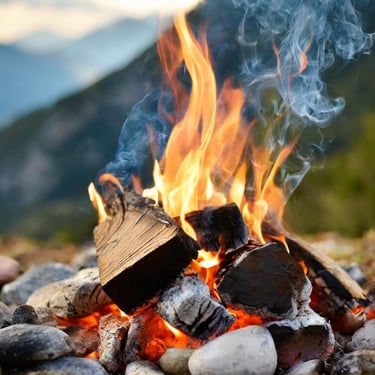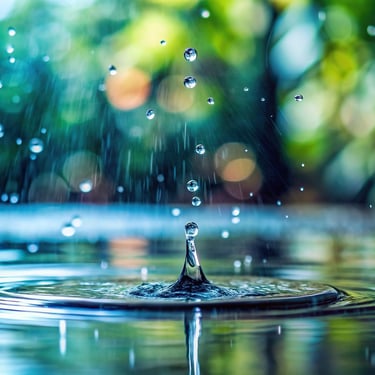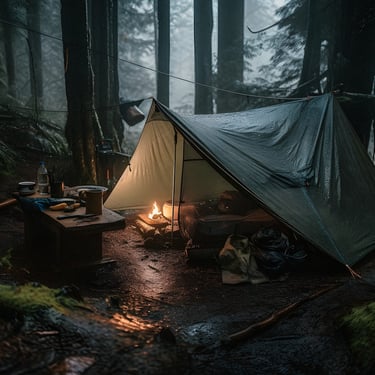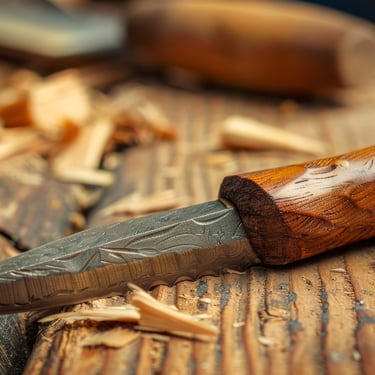BUSHCRAFT:
Bushcraft is more than just camping skills—it’s the art of thriving in the wild by using natural resources for shelter, tools, and food.




By mastering bushcraft techniques, you gain confidence and the ability to survive in emergencies or long-term off-grid situations. These skills are invaluable for outdoor enthusiasts, preppers, and anyone looking to reconnect with nature in a practical way.
1. Building Shelter from Natural Materials
A sturdy shelter is crucial to protect against the elements, regulate body temperature, and ensure comfort during wilderness stays. Exposure to cold, wind, or rain can quickly lead to hypothermia, making shelter one of the top priorities in bushcraft.
Types of Natural Shelters:
Lean-to Shelter: Simple to construct by propping branches against a horizontal beam. Great for short stays or emergency use.
Debris Hut: A-frame structure filled with leaves, moss, and debris for insulation. Ideal for cold environments.
Tarp and Branch Frame: Quick to set up with minimal resources. Tarp can double as rain cover or wind barrier.
Dugout Shelters: Dug into snow or soil for greater insulation and concealment, best for long-term survival in harsh climates.
Tip: Practice building a variety of shelters in different environments. Familiarize yourself with the materials in your local area, and time how long each structure takes to complete. This will help you refine your technique and efficiency.
Real-Life Example: During a snowstorm in the Rockies, a lost hiker survived by constructing a debris hut insulated with pine boughs and leaves. This simple structure helped him conserve body heat until rescue.
Do: Choose high ground and natural windbreaks when selecting a shelter location.
Don’t: Build your shelter in low-lying areas prone to flooding or near dead trees that could fall.
Top Pick: Emergency Tarp Shelter
UST Survival Tarp – Lightweight, durable, and easy to set up as part of a temporary shelter.
Add-on:
550 Paracord – Versatile cord essential for tying down shelters and building structures.
Recommended Book:
"Bushcraft 101: A Field Guide to the Art of Wilderness Survival" – A comprehensive guide on crafting shelter, tools, and more.
2. Foraging for Wild Edibles
Learning to identify edible plants, fruits, and fungi is essential for supplementing food in survival scenarios. Foraging can provide vitamins and minerals that enhance energy and overall health during extended periods in the wild.
Common Edibles:
Dandelion: Leaves, roots, and flowers are all edible and packed with nutrients.
Cattails: Stalks, roots, and pollen can be eaten. Found near water sources.
Wild Berries: Raspberries, blueberries, and blackberries grow in many regions.
Acorns: Can be processed by leaching tannins and then ground into flour.
Pine Nuts: Harvested from pine cones, high in fats and calories.
Tip: Start by learning 5-10 edible plants native to your region. Take foraging walks and bring a field guide to cross-check plants. Focus on safe, common plants like dandelions and wild onions. Create a foraging calendar that tracks which plants are available during each season.
Real-Life Scenario: After getting stranded in the Appalachian Mountains, a camper survived for four days by foraging wild berries and dandelions along trails until he was found.
Do: Test small amounts of new plants and wait 24 hours to ensure no allergic reaction.
Don’t: Consume plants growing near polluted water sources or roadsides.
Top Pick: Foraging Field Guide
Edible Wild Plants Field Guide – Comprehensive with clear images and identification tips.
Recommended Book:
"The Forager's Harvest" – A must-have for foraging enthusiasts.
3. Fire Craft and Primitive Cooking
Fire is essential for warmth, cooking, sterilizing water, and signaling for help. It also boosts morale in survival situations and helps keep predators at bay.
Fire Starting Techniques:
Ferro Rod and Striker: Reliable in wet conditions.
Fire Bow Drill: Traditional and primitive. Requires practice but no modern tools.
Flint and Steel: Creates sparks to ignite dry tinder.
Waterproof Matches and Lighters: Quick and easy but should always have backups.
Actionable Tip: Practice starting a fire using only a ferro rod. Mastering this technique ensures you’ll always have fire, even when lighters fail. Store cotton balls dipped in petroleum jelly as a reliable fire starter.
Real-Life Scenario: A camper lost in the Adirondacks used a ferro rod to start a fire during heavy rain. His ability to dry clothes and boil water prevented hypothermia.
Do: Gather dry tinder and kindling before starting your fire.
Don’t: Leave fires unattended or extinguish improperly.
Top Pick: Ferro Rod Fire Starter
Bayite Ferro Rod – Reliable and long-lasting for emergency fire starting.
Recommended Book:
"Advanced Bushcraft" – Covers advanced fire-making techniques and primitive cooking.
4. Crafting Tools and Weapons
Crafting tools and simple weapons from natural materials is essential for bushcraft survival. Items like stone knives, spears, and wooden traps provide food, protection, and aid in shelter building.
Essential Tools to Craft:
Stone Knife: Sharpened rock bound to a wooden handle using cordage.
Spears: Harden the tip by fire, useful for hunting and fishing.
Bow and Arrow: Provides ranged hunting capabilities.
Do: Practice carving tools regularly to improve precision and efficiency.
Don’t: Rush the process—poorly crafted tools can break and cause injury.
Recommended Book:
5. Water Purification and Storage
Access to clean water is vital for survival. In the wild, you cannot always rely on natural water sources to be safe. Learning purification methods and effective storage can prevent dehydration and waterborne illnesses.
Purification Techniques:
Boiling: The most reliable way to kill pathogens. Boil water for at least one minute (or three at higher elevations).
Filtering: Use portable water filters to remove debris, bacteria, and protozoa.
Chemical Treatment: Purify with iodine tablets or chlorine drops. Follow dosage instructions carefully.
Solar Distillation: Create a solar still to evaporate and collect purified water in survival situations.
Storage Methods:
Collapsible Water Containers: Space-saving and easy to transport.
Rainwater Collection: Set up tarps to channel rainwater into containers.
Water Bladders: Ideal for longer storage and carrying large amounts of water.
Actionable Tip: Always carry at least two purification methods when venturing outdoors. Practice building a solar still or filter from natural materials to enhance your emergency skills.
Real-Life Scenario: In the aftermath of a hurricane, a prepper family relied on a portable filter and rainwater collection system for two weeks when local utilities were down.
Do: Filter and boil water from lakes, rivers, and ponds.
Don’t: Assume clear water is safe to drink without treatment.
Top Pick: Portable Water Filter
LifeStraw Personal Water Filter – Removes 99.99% of bacteria and protozoa, lightweight, and easy to carry.
Recommended Book:
"The Prepper's Water Survival Guide" – A guide to collecting, filtering, and storing water during emergencies.
6. Navigation and Orientation in the Wild
Navigating without GPS is a crucial bushcraft skill. Understanding how to use maps, compasses, and natural signs can mean the difference between finding safety and getting lost.
Techniques for Navigation:
Compass and Map Reading: Learn to use a compass in conjunction with a map to orient yourself.
Natural Landmarks: Use mountains, rivers, and the position of the sun to guide your direction.
Star Navigation: At night, locate the North Star (Polaris) in the Northern Hemisphere or use constellations for orientation.
Tracking and Trail Signs: Mark trails subtly with rock stacks, broken branches, or chalk to retrace your steps.
Tip: Practice navigating short trails with only a map and compass. Memorize key constellations for nighttime navigation.
Real-Life Scenario: A hiker disoriented by fog successfully navigated back to camp by using a compass and tracking natural water flows downhill.
Do: Carry a physical map of the area and compass whenever hiking or camping.
Don’t: Rely solely on electronic GPS devices—batteries can fail or signals can be lost.
Top Pick: Compass and Map Set
SUUNTO MC-2 Compass – Professional-grade compass with mirror and precision accuracy.
Recommended Book:
"Wilderness Navigation" – Teaches navigation skills using maps, compass, and GPS.
Mastering bushcraft skills is not just about preparing for emergencies—it's about developing self-reliance, resilience, and a deeper connection with nature. From crafting tools to purifying water, these techniques empower you to handle challenging environments confidently.
Next Steps:
Begin with small projects—build a shelter or start a fire without matches.
Gradually expand your skills to crafting tools, foraging, and navigation.
Invest in quality gear and books that align with your bushcraft journey.
With practice and the right resources, you'll be equipped to face the unexpected and thrive in the wild.
Disclaimer:
This site contains affiliate links to Amazon. As an Amazon Associate, I may earn a commission from qualifying purchases. Your support helps keep the site running, with no extra charge to you.
The information provided on this website is for general informational purposes only. While we strive to ensure accuracy and reliability, the content is not intended as professional advice. Always consult with qualified professionals for specific needs or situations.
